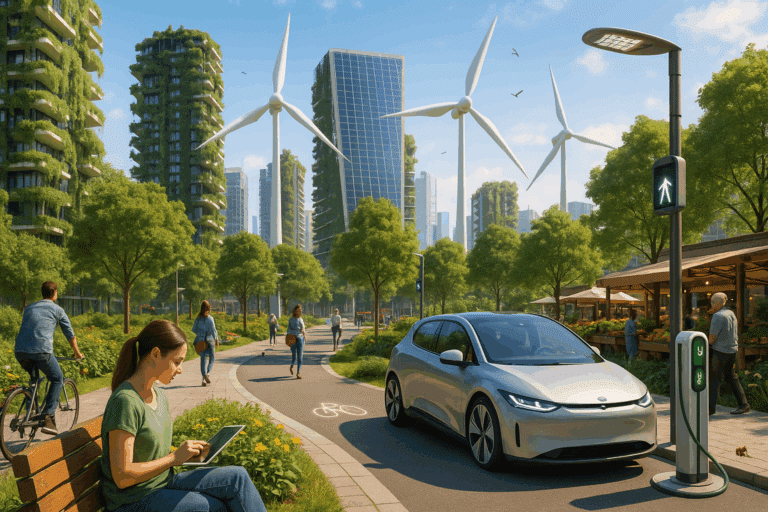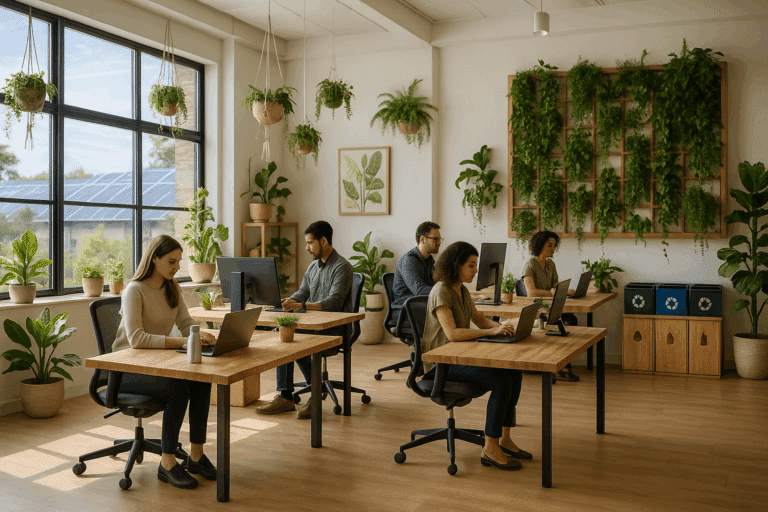🌿
Around you, workstations are not just ergonomically designed but are also integrated with live plants, bringing a touch of nature indoors. The windows are optimized for natural light, drastically reducing the need for artificial lighting. Water dispensers have been replaced with refill stations that cut back on plastic waste. And all around, you see technology designed with sustainability in mind.
These are not the offices of a distant future, but the vanguard of a rapidly growing trend: greening the office. More and more, businesses are realizing that a sustainable workplace is not just good for the planet—it’s good for productivity, morale, and the bottom line. And as we move toward a greener future, these offices are leading the way. 🌎
In this comprehensive guide, we’ll take you on a deep dive into the world of sustainable workplaces, exploring the key trends, benefits, and how-to’s of greening the office. We’ll delve into topics such as energy efficiency, waste reduction, and biophilic design, drawing on the latest research and real-world case studies. So, whether you’re a business owner looking to transform your workspace or an employee keen to make a difference, there’s something for you here.
💡 The Green Office Revolution
First, we’ll take a look at the broader trend of sustainable workplaces, tracing its origins, examining its growth, and predicting where it’s headed. We’ll discuss the key factors driving this shift, from increasing environmental awareness to changes in work culture. And we’ll show how sustainability is being integrated into every aspect of office design, operations, and management.
🌱 The Benefits of Greening the Office
Next, we’ll delve into the many benefits of a sustainable workplace. We’ll cover the environmental benefits, of course, but also the surprising ways in which going green can boost productivity, employee wellbeing, and even your brand’s reputation.
🔄 Creating a Sustainable Office
Then, we’ll provide practical tips for creating a green office, with advice for both big changes and small tweaks. We’ll share the most effective strategies for energy and waste reduction, as well as guidance on choosing sustainable materials and technologies. And we’ll provide resources for implementing green policies and practices in your workplace.
🌿 Biophilic Design and the Green Office
Finally, we’ll explore the emerging field of biophilic design, which aims to reconnect people with nature in the built environment. We’ll explain the principles of biophilic design, show how it’s being used in office settings, and demonstrate its potential to enhance both sustainability and wellbeing.
As we navigate through the green office revolution, remember that every step towards sustainability, no matter how small, makes a difference. So, let’s embark on this journey together, exploring how we can create workplaces that are not just productive and innovative, but also in harmony with our planet. 🌿🌍
The Emergence of Sustainable Workplaces: A Path to a Greener Future
In a world where climate change is a pressing issue, the movement towards sustainability in the workplace is a crucial step in our fight against environmental degradation. It’s not just about turning off lights when they’re not in use or recycling paper, it’s about changing our habits and adopting new ways of doing things. With offices being a significant contributor to greenhouse gas emissions and waste production, greening the office can make a significant impact on our environment.
In this article, we’re going to delve into the world of sustainable workplaces, looking at why they’re important, how they’re being implemented, and what benefits they can bring to companies and employees alike. We will also look at some real-world examples of businesses leading the way in this field.
One way to understand this concept better is through the video “Sustainable Workplaces: Leading the Way to a Greener Future” by the YouTube channel Sustainability Illustrated. It provides an excellent overview of how businesses can transform their offices into eco-friendly spaces.
The Importance of Sustainable Workplaces
The primary importance of sustainable workplaces is, of course, their potential for environmental impact. Offices consume vast amounts of energy, generate significant amounts of waste, and contribute to environmental pollution in various ways. By making workplaces more sustainable, we can reduce these impacts and help preserve our environment for future generations.
But the benefits of sustainable workplaces go beyond the environment. They can also improve employee well-being, enhance brand image, and even save companies money in the long term. Furthermore, as sustainability becomes a more prominent issue in society, consumers and employees alike are increasingly looking to associate with companies that take their environmental responsibilities seriously.
Consider the following comparative table, which highlights some key differences between traditional and sustainable workplaces:
| Aspect | Traditional Workplace | Sustainable Workplace |
|---|---|---|
| Energy Use | High | Reduced through efficiency measures and renewable energy sources |
| Waste Generation | High | Minimized through waste reduction strategies and recycling programs |
| Employee Health and Wellbeing | Potentially compromised due to poor indoor air quality and lighting | Enhanced through improved air quality, natural lighting, and green spaces |
| Brand Image | Neutral or negative if environmental impact is high | Positive, demonstrating a commitment to sustainability |
| Cost | Can be high due to energy and waste disposal costs | Potentially lower in the long term due to energy savings and waste reduction |
Implementing Sustainable Practices in the Workplace
So how do we go about creating a sustainable workplace? It’s a multi-faceted process that involves various elements, from energy efficiency and waste reduction to employee education and engagement. This section will look at some key strategies for greening the office.
Energy efficiency is often the first port of call when it comes to sustainable workplaces. This can involve measures such as installing energy-efficient lighting and appliances, improving insulation, and using renewable energy sources. Such changes can significantly reduce a company’s carbon footprint and also result in substantial cost savings in the long term.
Waste reduction is another critical area. This can involve strategies such as reducing paper use, implementing recycling programs, and even composting organic waste. Additionally, companies can encourage employees to reduce their waste by providing reusable cups and cutlery, for example.
Employee engagement is also a crucial element of a sustainable workplace. This can involve educating employees about sustainability, involving them in green initiatives, and even incentivizing sustainable behaviors. Check out this video “5 Ways to Engage Your Employees in Sustainability” by YouTube channel GreenBiz for more ideas.
Leading the Way: Examples of Sustainable Workplaces
Many companies around the world are leading the way when it comes to sustainable workplaces. These companies are not only reducing their environmental impact but also reaping numerous benefits in the process.
For example, Google’s offices are renowned for their sustainability efforts. From solar panels and energy-efficient buildings to extensive recycling programs and green commuting options, Google is a prime example of what a sustainable workplace can look like.
Another example is IKEA, which has committed to becoming a fully circular business by 2030. This includes efforts to minimize waste, use renewable and recycled materials, and design products with their end-of-life in mind. IKEA also encourages its employees to live more sustainably, with initiatives such as its “Live Lagom” program.
These examples serve as inspiration for other businesses looking to go green. Remember, every step towards a more sustainable workplace is a step towards a greener future. Watch “The Green Office: Sustainable Workplaces” by the YouTube channel GreenEnergyFutures for more inspiration and insights into this exciting field.

Conclusion
In conclusion, it’s clear that the world of technology and engineering is evolving at a rapid pace. Through our deep-dive exploration, we’ve touched on some of the key areas, providing a comprehensive insight into technical writing and its value in the IT and engineering sectors. 🎯
We kicked things off by highlighting the importance of technical writing. This specialized form of communication is critical for conveying complex information in a manner that’s easily digestible. The true power of technical writing lies in its ability to transform intricate, jargon-filled information into clear, concise, and understandable content, making it an indispensable skill in the IT and engineering fields. 👨💻
Next, we delved into the nuances of technical writing in the IT and engineering sectors. We discussed how a technical writer, like myself, plays a pivotal role in areas such as software development, hardware manufacturing, and engineering projects. As a technical writer, I can confirm that our work involves not only writing manuals, but also creating tutorials, FAQs, knowledge base articles, and much more. 📚
Subsequently, we addressed the challenges faced by technical writers. From comprehending complex concepts to explaining them in simple terms, the task is anything but easy. However, these challenges can be overcome with a solid foundation in the subject matter, a knack for simplifying complex ideas, and a strong command over language. 👊
We also touched upon the potential career paths for technical writers, demonstrating that it’s not a dead-end job but a gateway to a multitude of opportunities. From becoming a project manager to a UX designer or a content strategist, the career possibilities are truly expansive. 🚀
Last but not least, we discussed the future of technical writing. With the advent of AI and machine learning, the landscape of technical writing is set to transform. However, the human touch will remain irreplaceable, since AI, as advanced as it may be, cannot replicate the nuances and emotions conveyed by human language. 🤖
To wrap things up, technical writing is not just about explaining complex concepts in a simplified manner. It’s about bridging the gap between experts and laymen, and facilitating understanding and learning. It’s about making the world of technology and engineering more accessible and less intimidating.
So, whether you are a technical writer, an aspiring one, or someone interested in the field, I hope you found this article insightful and informative. I encourage you to comment below, share this article with your peers, or even apply what you’ve learned to your next project. 🤝
For further reading, check out this comprehensive guide on technical writing from [TechWhirl](https://techwhirl.com/what-is-technical-writing/). Also, consider visiting [Society for Technical Communication](https://www.stc.org/) for additional resources and networking opportunities.
Stay tuned for more in-depth articles on technical writing and other related fields. Until then, keep learning, keep exploring, and remember – the world of technology and engineering is vast and ever-evolving, and so is the field of technical writing. 🌐
References:
- [TechWhirl – What is Technical Writing?](https://techwhirl.com/what-is-technical-writing/)
- [Society for Technical Communication](https://www.stc.org/)



